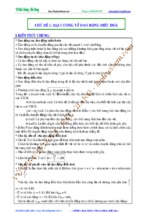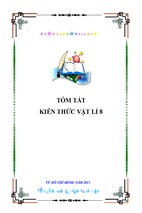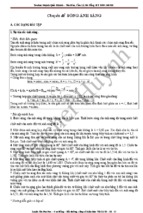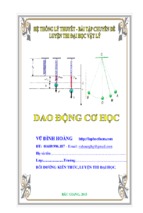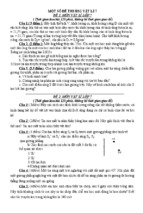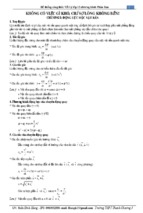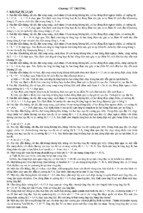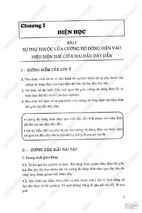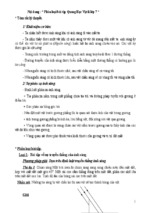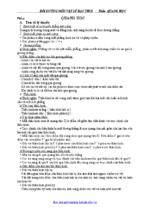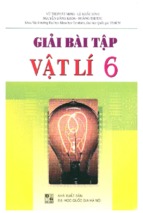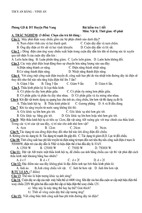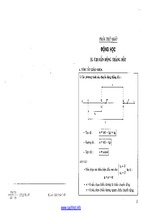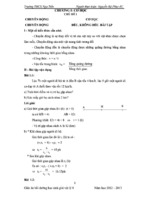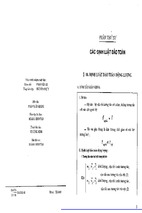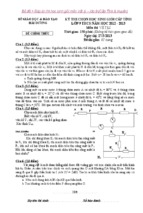INTRODUCTION TO
MAGNETIC MATERIALS
IEEE Press
445 Hoes Lane
Piscataway, NJ 08854
IEEE Press Editorial Board
Lajos Hanzo, Editor in Chief
R. Abari
J. Anderson
S. Basu
A. Chatterjee
T. Chen
T. G. Croda
S. Farshchi
B. M. Hammerli
O. Malik
S. Nahavandi
M. S. Newman
W. Reeve
Kenneth Moore, Director of IEEE Book and Information Services (BIS)
Steve Welch, Acquisitions Editor
Jeanne Audino, Project Editor
IEEE Magnetics Society, Sponsor
IEEE Magnetics Society Liaisons to IEEE Press, Liesl Folks and John T. Scott
Technical Reviewers
Stanley H. Charap, Emeritus Professor, Carnegie Mellon University
John T. Scott, American Institute of Physics, Retired
INTRODUCTION TO
MAGNETIC MATERIALS
Second Edition
B. D. CULLITY
University of Notre Dame
C. D. GRAHAM
University of Pennsylvania
Copyright # 2009 by the Institute of Electrical and Electronics Engineers, Inc.
Published by John Wiley & Sons, Inc., Hoboken, New Jersey. All rights reserved.
Published simultaneously in Canada
No part of this publication may be reproduced, stored in a retrieval system, or transmitted in any form or by any
means, electronic, mechanical, photocopying, recording, scanning, or otherwise, except as permitted under Section
107 or 108 of the 1976 United States Copyright Act, without either the prior written permission of the Publisher, or
authorization through payment of the appropriate per-copy fee to the Copyright Clearance Center, Inc., 222
Rosewood Drive, Danvers, MA 01923, (978) 750-8400, fax (978) 750-4470, or on the web at www.copyright.
com. Requests to the Publisher for permission should be addressed to the Permissions Department, John Wiley
& Sons, Inc., 111 River Street, Hoboken, NJ 07030, (201) 748-6011, fax (201) 748-6008, or online at http://
www.wiley.com/go/permission.
Limit of Liability/Disclaimer of Warranty: While the publisher and author have used their best efforts in preparing
this book, they make no representations or warranties with respect to the accuracy or completeness of the contents
of this book and specifically disclaim any implied warranties of merchantability or fitness for a particular purpose.
No warranty may be created or extended by sales representatives or written sales materials. The advice and
strategies contained herein may not be suitable for your situation. You should consult with a professional where
appropriate. Neither the publisher nor author shall be liable for any loss of profit or any other commercial
damages, including but not limited to special, incidental, consequential, or other damages.
For general information on our other products and services or for technical support, please contact our Customer
Care Department within the United States at (800) 762-2974, outside the United States at (317) 572-3993 or fax
(317) 572-4002.
Wiley also publishes its books in a variety of electronic formats. Some content that appears in print may not be
available in electronic formats. For more information about Wiley products, visit our web site at www.wiley.com.
Library of Congress Cataloging-in-Publication Data is available:
ISBN 978-0-471-47741-9
Printed in the United States of America
10 9 8
7 6
5 4 3
2 1
CONTENTS
PREFACE TO THE FIRST EDITION
xiii
PREFACE TO THE SECOND EDITION
xvi
1
DEFINITIONS AND UNITS
1.1
1.2
1.3
1.4
1.5
1.6
1.7
1.8
1.9
2
Introduction / 1
The cgs – emu System of Units / 2
1.2.1 Magnetic Poles / 2
Magnetic Moment / 5
Intensity of Magnetization / 6
Magnetic Dipoles / 7
Magnetic Effects of Currents / 8
Magnetic Materials / 10
SI Units / 16
Magnetization Curves and Hysteresis Loops / 18
EXPERIMENTAL METHODS
2.1
2.2
2.3
2.4
1
23
Introduction / 23
Field Production By Solenoids / 24
2.2.1 Normal Solenoids / 24
2.2.2 High Field Solenoids / 28
2.2.3 Superconducting Solenoids / 31
Field Production by Electromagnets / 33
Field Production by Permanent Magnets / 36
v
vi
CONTENTS
Measurement of Field Strength / 38
2.5.1 Hall Effect / 38
2.5.2 Electronic Integrator or Fluxmeter / 39
2.5.3 Other Methods / 41
2.6 Magnetic Measurements in Closed Circuits / 44
2.7 Demagnetizing Fields / 48
2.8 Magnetic Shielding / 51
2.9 Demagnetizing Factors / 52
2.10 Magnetic Measurements in Open Circuits / 62
2.11 Instruments for Measuring Magnetization / 66
2.11.1 Extraction Method / 66
2.11.2 Vibrating-Sample Magnetometer / 67
2.11.3 Alternating (Field) Gradient Magnetometer—AFGM or AGM
(also called Vibrating Reed Magnetometer) / 70
2.11.4 Image Effect / 70
2.11.5 SQUID Magnetometer / 73
2.11.6 Standard Samples / 73
2.11.7 Background Fields / 73
2.12 Magnetic Circuits and Permeameters / 73
2.12.1 Permeameter / 77
2.12.2 Permanent Magnet Materials / 79
2.13 Susceptibility Measurements / 80
Problems / 85
2.5
3
DIAMAGNETISM AND PARAMAGNETISM
Introduction / 87
Magnetic Moments of Electrons / 87
Magnetic Moments of Atoms / 89
Theory of Diamagnetism / 90
Diamagnetic Substances / 90
Classical Theory of Paramagnetism / 91
Quantum Theory of Paramagnetism / 99
3.7.1 Gyromagnetic Effect / 102
3.7.2 Magnetic Resonance / 103
3.8 Paramagnetic Substances / 110
3.8.1 Salts of the Transition Elements / 110
3.8.2 Salts and Oxides of the Rare Earths / 110
3.8.3 Rare-Earth Elements / 110
3.8.4 Metals / 111
3.8.5 General / 111
Problems / 113
3.1
3.2
3.3
3.4
3.5
3.6
3.7
87
CONTENTS
4
FERROMAGNETISM
vii
115
4.1 Introduction / 115
4.2 Molecular Field Theory / 117
4.3 Exchange Forces / 129
4.4 Band Theory / 133
4.5 Ferromagnetic Alloys / 141
4.6 Thermal Effects / 145
4.7 Theories of Ferromagnetism / 146
4.8 Magnetic Analysis / 147
Problems / 149
5
ANTIFERROMAGNETISM
151
Introduction / 151
Molecular Field Theory / 154
5.2.1 Above TN / 154
5.2.2 Below TN / 156
5.2.3 Comparison with Experiment / 161
5.3 Neutron Diffraction / 163
5.3.1 Antiferromagnetic / 171
5.3.2 Ferromagnetic / 171
5.4 Rare Earths / 171
5.5 Antiferromagnetic Alloys / 172
Problems / 173
5.1
5.2
6
FERRIMAGNETISM
Introduction / 175
Structure of Cubic Ferrites / 178
Saturation Magnetization / 180
Molecular Field Theory / 183
6.4.1 Above Tc / 184
6.4.2 Below Tc / 186
6.4.3 General Conclusions / 189
6.5 Hexagonal Ferrites / 190
6.6 Other Ferrimagnetic Substances / 192
6.6.1 g-Fe2O3 / 192
6.6.2 Garnets / 193
6.6.3 Alloys / 193
6.7 Summary: Kinds of Magnetism / 194
Problems / 195
6.1
6.2
6.3
6.4
175
viii
7
CONTENTS
MAGNETIC ANISOTROPY
197
Introduction / 197
Anisotropy in Cubic Crystals / 198
Anisotropy in Hexagonal Crystals / 202
Physical Origin of Crystal Anisotropy / 204
Anisotropy Measurement / 205
7.5.1 Torque Curves / 206
7.5.2 Torque Magnetometers / 212
7.5.3 Calibration / 215
7.5.4 Torsion-Pendulum Method / 217
7.6 Anisotropy Measurement (from Magnetization Curves) / 218
7.6.1 Fitted Magnetization Curve / 218
7.6.2 Area Method / 222
7.6.3 Anisotropy Field / 226
7.7 Anisotropy Constants / 227
7.8 Polycrystalline Materials / 229
7.9 Anisotropy in Antiferromagnetics / 232
7.10 Shape Anisotropy / 234
7.11 Mixed Anisotropies / 237
Problems / 238
7.1
7.2
7.3
7.4
7.5
8
MAGNETOSTRICTION AND THE EFFECTS OF STRESS
241
Introduction / 241
Magnetostriction of Single Crystals / 243
8.2.1 Cubic Crystals / 245
8.2.2 Hexagonal Crystals / 251
8.3 Magnetostriction of Polycrystals / 254
8.4 Physical Origin of Magnetostriction / 257
8.4.1 Form Effect / 258
8.5 Effect of Stress on Magnetic Properties / 258
8.6 Effect of Stress on Magnetostriction / 266
8.7 Applications of Magnetostriction / 268
8.8 DE Effect / 270
8.9 Magnetoresistance / 271
Problems / 272
8.1
8.2
9
DOMAINS AND THE MAGNETIZATION PROCESS
9.1
9.2
Introduction / 275
Domain Wall Structure / 276
9.2.1 Néel Walls / 283
275
CONTENTS
ix
Domain Wall Observation / 284
9.3.1 Bitter Method / 284
9.3.2 Transmission Electron Microscopy / 287
9.3.3 Optical Effects / 288
9.3.4 Scanning Probe; Magnetic Force
Microscope / 290
9.3.5 Scanning Electron Microscopy with
Polarization Analysis / 292
9.4 Magnetostatic Energy and Domain Structure / 292
9.4.1 Uniaxial Crystals / 292
9.4.2 Cubic Crystals / 295
9.5 Single-Domain Particles / 300
9.6 Micromagnetics / 301
9.7 Domain Wall Motion / 302
9.8 Hindrances to Wall Motion (Inclusions) / 305
9.8.1 Surface Roughness / 308
9.9 Residual Stress / 308
9.10 Hindrances to Wall Motion (Microstress) / 312
9.11 Hindrances to Wall Motion (General) / 312
9.12 Magnetization by Rotation / 314
9.12.1 Prolate Spheroid (Cigar) / 314
9.12.2 Planetary (Oblate) Spheroid / 320
9.12.3 Remarks / 321
9.13 Magnetization in Low Fields / 321
9.14 Magnetization in High Fields / 325
9.15 Shapes of Hysteresis Loops / 326
9.16 Effect of Plastic Deformation (Cold Work) / 329
Problems / 332
9.3
10 INDUCED MAGNETIC ANISOTROPY
10.1
10.2
10.3
10.4
10.5
10.6
10.7
10.8
Introduction / 335
Magnetic Annealing (Substitutional
Solid Solutions) / 336
Magnetic Annealing (Interstitial
Solid Solutions) / 345
Stress Annealing / 348
Plastic Deformation (Alloys) / 349
Plastic Deformation (Pure Metals) / 352
Magnetic Irradiation / 354
Summary of Anisotropies / 357
335
x
CONTENTS
11 FINE PARTICLES AND THIN FILMS
359
Introduction / 359
Single-Domain vs Multi-Domain Behavior / 360
Coercivity of Fine Particles / 360
Magnetization Reversal by Spin Rotation / 364
11.4.1 Fanning / 364
11.4.2 Curling / 368
11.5 Magnetization Reversal by Wall Motion / 373
11.6 Superparamagnetism in Fine Particles / 383
11.7 Superparamagnetism in Alloys / 390
11.8 Exchange Anisotropy / 394
11.9 Preparation and Structure of Thin Films / 397
11.10 Induced Anisotropy in Films / 399
11.11 Domain Walls in Films / 400
11.12 Domains in Films / 405
Problems / 408
11.1
11.2
11.3
11.4
12 MAGNETIZATION DYNAMICS
409
Introduction / 409
Eddy Currents / 409
Domain Wall Velocity / 412
12.3.1 Eddy-Current Damping / 415
12.4 Switching in Thin Films / 418
12.5 Time Effects / 421
12.5.1 Time Decrease of Permeability / 422
12.5.2 Magnetic After-Effect / 424
12.5.3 Thermal Fluctuation After-Effect / 426
12.6 Magnetic Damping / 428
12.6.1 General / 433
12.7 Magnetic Resonance / 433
12.7.1 Electron Paramagnetic Resonance / 433
12.7.2 Ferromagnetic Resonance / 435
12.7.3 Nuclear Magnetic Resonance / 436
Problems / 438
12.1
12.2
12.3
13 Soft Magnetic Materials
13.1
13.2
13.3
Introduction / 439
Eddy Currents / 440
Losses in Electrical Machines / 445
13.3.1 Transformers / 445
13.3.2 Motors and Generators / 450
439
CONTENTS
xi
Electrical Steel / 452
13.4.1 Low-Carbon Steel / 453
13.4.2 Nonoriented Silicon Steel / 454
13.4.3 Grain-Oriented Silicon Steel / 456
13.4.4 Six Percent Silicon Steel / 460
13.4.5 General / 461
13.5 Special Alloys / 463
13.5.1 Iron– Cobalt Alloys / 466
13.5.2 Amorphous and Nanocrystalline
Alloys / 466
13.5.3 Temperature Compensation Alloys / 467
13.5.4 Uses of Soft Magnetic Materials / 467
13.6 Soft Ferrites / 471
Problems / 476
13.4
14 HARD MAGNETIC MATERIALS
14.1
14.2
14.3
14.4
14.5
14.6
14.7
14.8
14.9
14.10
14.11
14.12
14.13
14.14
Introduction / 477
Operation of Permanent Magnets / 478
Magnet Steels / 484
Alnico / 485
Barium and Strontium Ferrite / 487
Rare Earth Magnets / 489
14.6.1 SmCo5 / 489
14.6.2 Sm2Co17 / 490
14.6.3 FeNdB / 491
Exchange-Spring Magnets / 492
Nitride Magnets / 492
Ductile Permanent Magnets / 492
14.9.1 Cobalt Platinum / 493
Artificial Single Domain Particle
Magnets (Lodex) / 493
Bonded Magnets / 494
Magnet Stability / 495
14.12.1 External Fields / 495
14.12.2 Temperature Changes / 496
Summary of Magnetically Hard Materials / 497
Applications / 498
14.14.1 Electrical-to-Mechanical / 498
14.14.2 Mechanical-to-Electrical / 501
14.14.3 Microwave Equipment / 501
14.14.4 Wigglers and Undulators / 501
477
xii
CONTENTS
14.14.5 Force Applications / 501
14.14.6 Magnetic Levitation / 503
Problems / 504
15 MAGNETIC MATERIALS FOR RECORDING
AND COMPUTERS
15.1
15.2
15.3
15.4
15.5
15.6
15.7
15.8
Introduction / 505
Magnetic Recording / 505
15.2.1 Analog Audio and Video Recording / 505
Principles of Magnetic Recording / 506
15.3.1 Materials Considerations / 507
15.3.2 AC Bias / 507
15.3.3 Video Recording / 508
Magnetic Digital Recording / 509
15.4.1 Magnetoresistive Read Heads / 509
15.4.2 Colossal Magnetoresistance / 511
15.4.3 Digital Recording Media / 511
Perpendicular Recording / 512
Possible Future Developments / 513
Magneto-Optic Recording / 513
Magnetic Memory / 514
15.8.1 Brief History / 514
15.8.2 Magnetic Random Access Memory / 515
15.8.3 Future Possibilities / 515
16 MAGNETIC PROPERTIES OF SUPERCONDUCTORS
16.1
16.2
16.3
16.4
16.5
505
517
Introduction / 517
Type I Superconductors / 519
Type II Superconductors / 520
Susceptibility Measurements / 523
Demagnetizing Effects / 525
APPENDIX 1: DIPOLE FIELDS AND ENERGIES
527
APPENDIX 2: DATA ON FERROMAGNETIC ELEMENTS
531
APPENDIX 3: CONVERSION OF UNITS
533
APPENDIX 4: PHYSICAL CONSTANTS
535
INDEX
537
PREFACE TO THE FIRST EDITION
Take a pocket compass, place it on a table, and watch the needle. It will jiggle around,
oscillate, and finally come to rest, pointing more or less north. Therein lie two mysteries.
The first is the origin of the earth’s magnetic field, which directs the needle. The second
is the origin of the magnetism of the needle, which allows it to be directed. This book
is about the second mystery, and a mystery indeed it is, for although a great deal is
known about magnetism in general, and about the magnetism of iron in particular, it
is still impossible to predict from first principles that iron is strongly magnetic.
This book is for the beginner. By that I mean a senior or first-year graduate student in
engineering, who has had only the usual undergraduate courses in physics and materials
science taken by all engineers, or anyone else with a similar background. No knowledge
of magnetism itself is assumed.
People who become interested in magnetism usually bring quite different backgrounds to
their study of the subject. They are metallurgists and physicists, electrical engineers and
chemists, geologists and ceramists. Each one has a different amount of knowledge of
such fundamentals as atomic theory, crystallography, electric circuits, and crystal chemistry.
I have tried to write understandably for all groups. Thus some portions of the book will be
extremely elementary for most readers, but not the same portions for all readers.
Despite the popularity of the mks system of units in electricity, the overwhelming
majority of magneticians still speak the language of the cgs system, both in the laboratory
and in the plant. The student must learn that language sooner or later. This book is therefore
written in the cgs system.
The beginner in magnetism is bewildered by a host of strange units and even stranger
measurements. The subject is often presented on too theoretical a level, with the result
that the student has no real physical understanding of the various quantities involved,
simply because he has no clear idea of how these quantities are measured. For this
reason methods of measurement are stressed throughout the book. All of the second
chapter is devoted to the most common methods, while more specialized techniques are
described in appropriate later chapters.
xiii
xiv
PREFACE TO THE FIRST EDITION
The book is divided into four parts:
1. Units and measurements.
2. Kinds of magnetism, or the difference, for example, between a ferromagnetic and a
paramagnetic.
3. Phenomena in strongly magnetic substances, such as anisotropy and magnetostriction.
4. Commercial magnetic materials and their applications.
The references, selected from the enormous literature of magnetism, are mainly of two
kinds, review papers and classic papers, together with other references required to buttress
particular statements in the text. In addition, a list of books is given, together with brief indications of the kind of material that each contains.
Magnetism has its roots in antiquity. No one knows when the first lodestone, a natural
oxide of iron magnetized by a bolt of lightning, was picked up and found to attract bits of
other lodestones or pieces of iron. It was a subject bound to attract the superstitious, and it
did. In the sixteenth century Gilbert began to formulate some clear principles.
In the late nineteenth and early twentieth centuries came the really great contributions of
Curie, Langevin, and Weiss, made over a span of scarcely more than ten years. For the next
forty years the study of magnetism can be said to have languished, except for the work of a
few devotees who found in the subject that fascinations so eloquently described by the late
Professor E. C. Stoner:
The rich diversity of ferromagnetic phenomena, the perennial
challenge to skill in experiment and to physical insight in
coordinating the results, the vast range of actual and
possible applications of ferromagnetic materials, and the
fundamental character of the essential theoretical problems
raised have all combined to give ferromagnetism a width of
interest which contrasts strongly with the apparent narrowness
of its subject matter, namely, certain particular properties
of a very limited number of substances.
Then, with the end of World War II, came a great revival of interest, and the study of
magnetism has never been livelier than it is today. This renewed interest came mainly
from three developments:
1. A new material. An entirely new class of magnetic materials, the ferrites, was developed, explained, and put to use.
2. A new tool. Neutron diffraction, which enables us to “see” the magnetic moments of
individual atoms, has given new depth to the field of magnetochemistry.
3. A new application. The rise of computers, in which magnetic devices play an essential role, has spurred research on both old and new magnetic materials.
And all this was aided by a better understanding, gained about the same time, of magnetic
domains and how they behave.
In writing this book, two thoughts have occurred to me again and again. The first is that
magnetism is peculiarly a hidden subject, in the sense that it is all around us, part of our
PREFACE TO THE FIRST EDITION
xv
daily lives, and yet most people, including engineers, are unaware or have forgotten that
their lives would be utterly different without magnetism. There would be no electric
power as we know it, no electric motors, no radio, no TV. If electricity and magnetism
are sister sciences, then magnetism is surely the poor relation. The second point concerns
the curious reversal, in the United States, of the usual roles of university and industrial laboratories in the area of magnetic research. While Americans have made sizable contributions to the international pool of knowledge of magnetic materials, virtually all of
these contributions have come from industry. This is not true of other countries or other
subjects. I do not pretend to know the reason for this imbalance, but it would certainly
seem to be time for the universities to do their share.
Most technical books, unless written by an authority in the field, are the result of a
collaborative effort, and I have had many collaborators. Many people in industry have
given freely from their fund of special knowledge and experiences. Many others have
kindly given me original photographs. The following have critically read portions of the
book or have otherwise helped me with difficult points: Charles W. Allen, Joseph J.
Becker, Ami E. Berkowitz, David Cohen, N. F. Fiore, C. D. Graham, Jr., Robert G.
Hayes, Eugene W. Henry, Conyers Herring, Gerald L. Jones, Fred E. Luborsky, Walter
C. Miller, R. Pauthenet, and E. P. Wohlfarth. To these and all others who have aided in
my magnetic education, my best thanks.
B. D. C.
Notre Dame, Indiana
February 1972
PREFACE TO THE SECOND EDITION
B. D. (Barney) Cullity (1917 – 1978) was a gifted writer on technical topics. He could
present complicated subjects in a clear, coherent, concise way that made his books
popular with students and teachers alike. His first book, on X-ray diffraction, taught the
elements of crystallography and structure and X-rays to generations of metallurgists. It
was first published in 1967, with a second edition in 1978 and a third updated version in
2001, by Stuart R. Stock. His book on magnetic materials appeared in 1972 and was similarly successful; it remained in print for many years and was widely used as an introduction
to the subjects of magnetism, magnetic measurements, and magnetic materials.
The Magnetics Society of the Institute of Electrical and Electronic Engineers (IEEE) has
for a number of years sponsored the reprinting of classic books and papers in the field of
magnetism, including perhaps most notably the reprinting in 1993 of R. M. Bozorth’s
monumental book Ferromagnetism, first published in 1952. Cullity’s Introduction to
Magnetic Materials was another candidate for reprinting, but after some debate it was
decided to encourage the production of a revised and updated edition instead. I had for
many years entertained the notion of making such a revision, and volunteered for the
job. It has taken considerably longer than I anticipated, and I have in the end made
fewer changes than might have been expected.
Cullity wrote explicitly for the beginner in magnetism, for an undergraduate student
or beginning graduate student with no prior exposure to the subject and with only a
general undergraduate knowledge of chemistry, physics, and mathematics. He emphasized
measurements and materials, especially materials of engineering importance. His treatment
of quantum phenomena is elementary. I have followed the original text quite closely in
organization and approach, and have left substantial portions largely unchanged. The
major changes include the following:
1. I have used both cgs and SI units throughout, where Cullity chose cgs only. Using
both undoubtedly makes for a certain clumsiness and repetition, but if (as I hope)
xvi
PREFACE TO THE SECOND EDITION
xvii
the book remains useful for as many years as the original, SI units will be increasingly
important.
2. The treatment of measurements has been considerably revised. The ballistic galvanometer and the moving-coil fluxmeter have been compressed into a single sentence.
The electronic integrator appears, along with the alternating-gradient magnetometer,
the SQUID, and the use of computers for data collection. No big surprises here.
3. There is a new chapter on magnetic materials for use in computers, and a brief chapter
on the magnetic behavior of superconductors.
4. Amorphous magnetic alloys and rare-earth permanent magnets appear, the treatment
of domain-wall structure and energy is expanded, and some work on the effect of
mechanical stresses on domain wall motion (a topic of special interest to Cullity)
has been dropped.
I considered various ways to deal with quantum mechanics. As noted above, Cullity’s treatment is sketchy, and little use is made of quantum phenomena in most of the book. One
possibility was simply to drop the subject entirely, and stick to classical physics. The
idea of expanding the treatment was quickly dropped. Apart from my personal limitations,
I do not believe it is possible to embed a useful textbook on quantum mechanics as a chapter
or two in a book that deals mainly with other subjects. In the end, I pretty much stuck with
Cullity’s original. It gives some feeling for the subject, without pretending to be rigorous or
detailed.
References
All technical book authors, including Cullity in 1972, bemoan the vastness of the technical
literature and the impossibility of keeping up with even a fraction of it. In working closely
with the book over several years, I became conscious of the fact that it has remained useful
even as its many references became obsolete. I also convinced myself that readers of the
revised edition will fall mainly into two categories: beginners, who will not need or
desire to go beyond what appears in the text; and more advanced students and research
workers, who will have easy access to computerized literature searches that will give
them up-to-date information on topics of interest rather than the aging references in an
aging text. So most of the references have been dropped. Those that remain appear
embedded in the text, and are to old original work, or to special sources of information
on specific topics, or to recent (in 2007) textbooks. No doubt this decision will disappoint
some readers, and perhaps it is simply a manifestation of authorial cowardice, but I felt it
was the only practical way to proceed.
I would like to express my thanks to Ron Goldfarb and his colleagues at the National
Institute of Science and Technology in Boulder, Colorado, for reading and criticizing the
individual chapters. I have adopted most of their suggestions.
C. D. GRAHAM
Philadelphia, Pennsylvania
May 2008
CHAPTER 1
DEFINITIONS AND UNITS
1.1
INTRODUCTION
The story of magnetism begins with a mineral called magnetite (Fe3O4), the first magnetic
material known to man. Its early history is obscure, but its power of attracting iron was certainly known 2500 years ago. Magnetite is widely distributed. In the ancient world the most
plentiful deposits occurred in the district of Magnesia, in what is now modern Turkey, and
our word magnet is derived from a similar Greek word, said to come from the name of this
district. It was also known to the Greeks that a piece of iron would itself become magnetic if
it were touched, or, better, rubbed with magnetite.
Later on, but at an unknown date, it was found that a properly shaped piece of magnetite,
if supported so as to float on water, would turn until it pointed approximately north and
south. So would a pivoted iron needle, if previously rubbed with magnetite. Thus was
the mariner’s compass born. This north-pointing property of magnetite accounts for the
old English word lodestone for this substance; it means “waystone,” because it points
the way.
The first truly scientific study of magnetism was made by the Englishman William
Gilbert (1540 – 1603), who published his classic book On the Magnet in 1600. He experimented with lodestones and iron magnets, formed a clear picture of the Earth’s magnetic
field, and cleared away many superstitions that had clouded the subject. For more than a
century and a half after Gilbert, no discoveries of any fundamental importance were
made, although there were many practical improvements in the manufacture of magnets.
Thus, in the eighteenth century, compound steel magnets were made, composed of many
magnetized steel strips fastened together, which could lift 28 times their own weight of
iron. This is all the more remarkable when we realize that there was only one way of
making magnets at that time: the iron or steel had to be rubbed with a lodestone, or with
Introduction to Magnetic Materials, Second Edition. By B. D. Cullity and C. D. Graham
Copyright # 2009 the Institute of Electrical and Electronics Engineers, Inc.
1
2
DEFINITIONS AND UNITS
another magnet which in turn had been rubbed with a lodestone. There was no other way
until the first electromagnet was made in 1825, following the great discovery made in 1820
by Hans Christian Oersted (1775– 1851) that an electric current produces a magnetic field.
Research on magnetic materials can be said to date from the invention of the electromagnet,
which made available much more powerful fields than those produced by lodestones, or
magnets made from them.
In this book we shall consider basic magnetic quantities and the units in which they are
expressed, ways of making magnetic measurements, theories of magnetism, magnetic behavior of materials, and, finally, the properties of commercially important magnetic materials.
The study of this subject is complicated by the existence of two different systems of units:
the SI (International System) or mks, and the cgs (electromagnetic or emu) systems. The SI
system, currently taught in all physics courses, is standard for scientific work throughout the
world. It has not, however, been enthusiastically accepted by workers in magnetism.
Although both systems describe the same physical reality, they start from somewhat different ways of visualizing that reality. As a consequence, converting from one system to the
other sometimes involves more than multiplication by a simple numerical factor. In
addition, the designers of the SI system left open the possibility of expressing some magnetic quantities in more than one way, which has not helped in speeding its adoption.
The SI system has a clear advantage when electrical and magnetic behavior must be considered together, as when dealing with electric currents generated inside a material by magnetic effects (eddy currents). Combining electromagnetic and electrostatic cgs units gets
very messy, whereas using SI it is straightforward.
At present (early twenty-first century), the SI system is widely used in Europe, especially
for soft magnetic materials (i.e., materials other than permanent magnets). In the USA and
Japan, the cgs – emu system is still used by the majority of research workers, although the
use of SI is slowly increasing. Both systems are found in reference works, research papers,
materials and instrument specifications, so this book will use both sets of units. In Chapter
1, the basic equations of each system will be developed sequentially; in subsequent chapters
the two systems will be used in parallel. However, not every equation or numerical value
will be duplicated; the aim is to provide conversions in cases where they are not obvious
or where they are needed for clarity.
Many of the equations in this introductory chapter and the next are stated without proof
because their derivations can be found in most physics textbooks.
1.2
1.2.1
THE cgs – emu SYSTEM OF UNITS
Magnetic Poles
Almost everyone as a child has played with magnets and felt the mysterious forces of
attraction and repulsion between them. These forces appear to originate in regions called
poles, located near the ends of the magnet. The end of a pivoted bar magnet which
points approximately toward the north geographic pole of the Earth is called the northseeking pole, or, more briefly, the north pole. Since unlike poles attract, and like poles
repel, this convention means that there is a region of south polarity near the north geographic pole. The law governing the forces between poles was discovered independently
in England in 1750 by John Michell (1724 – 1793) and in France in 1785 by Charles
Coulomb (1736– 1806). This law states that the force F between two poles is proportional
- Xem thêm -

